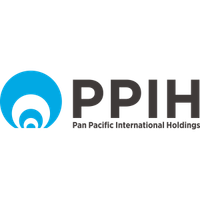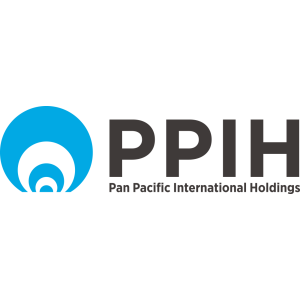
Pan Pacific International Holdings Corp
TSE:7532


| US |

|
Johnson & Johnson
NYSE:JNJ
|
Pharmaceuticals
|
| US |

|
Berkshire Hathaway Inc
NYSE:BRK.A
|
Financial Services
|
| US |

|
Bank of America Corp
NYSE:BAC
|
Banking
|
| US |

|
Mastercard Inc
NYSE:MA
|
Technology
|
| US |

|
UnitedHealth Group Inc
NYSE:UNH
|
Health Care
|
| US |

|
Exxon Mobil Corp
NYSE:XOM
|
Energy
|
| US |

|
Pfizer Inc
NYSE:PFE
|
Pharmaceuticals
|
| US |

|
Palantir Technologies Inc
NYSE:PLTR
|
Technology
|
| US |

|
Nike Inc
NYSE:NKE
|
Textiles, Apparel & Luxury Goods
|
| US |

|
Visa Inc
NYSE:V
|
Technology
|
| CN |

|
Alibaba Group Holding Ltd
NYSE:BABA
|
Retail
|
| US |

|
3M Co
NYSE:MMM
|
Industrial Conglomerates
|
| US |

|
JPMorgan Chase & Co
NYSE:JPM
|
Banking
|
| US |

|
Coca-Cola Co
NYSE:KO
|
Beverages
|
| US |

|
Walmart Inc
NYSE:WMT
|
Retail
|
| US |

|
Verizon Communications Inc
NYSE:VZ
|
Telecommunication
|
Utilize notes to systematically review your investment decisions. By reflecting on past outcomes, you can discern effective strategies and identify those that underperformed. This continuous feedback loop enables you to adapt and refine your approach, optimizing for future success.
Each note serves as a learning point, offering insights into your decision-making processes. Over time, you'll accumulate a personalized database of knowledge, enhancing your ability to make informed decisions quickly and effectively.
With a comprehensive record of your investment history at your fingertips, you can compare current opportunities against past experiences. This not only bolsters your confidence but also ensures that each decision is grounded in a well-documented rationale.
Do you really want to delete this note?
This action cannot be undone.

| 52 Week Range |
3 071
4 279
|
| Price Target |
|
We'll email you a reminder when the closing price reaches JPY.
Choose the stock you wish to monitor with a price alert.

|
Johnson & Johnson
NYSE:JNJ
|
US |

|
Berkshire Hathaway Inc
NYSE:BRK.A
|
US |

|
Bank of America Corp
NYSE:BAC
|
US |

|
Mastercard Inc
NYSE:MA
|
US |

|
UnitedHealth Group Inc
NYSE:UNH
|
US |

|
Exxon Mobil Corp
NYSE:XOM
|
US |

|
Pfizer Inc
NYSE:PFE
|
US |

|
Palantir Technologies Inc
NYSE:PLTR
|
US |

|
Nike Inc
NYSE:NKE
|
US |

|
Visa Inc
NYSE:V
|
US |

|
Alibaba Group Holding Ltd
NYSE:BABA
|
CN |

|
3M Co
NYSE:MMM
|
US |

|
JPMorgan Chase & Co
NYSE:JPM
|
US |

|
Coca-Cola Co
NYSE:KO
|
US |

|
Walmart Inc
NYSE:WMT
|
US |

|
Verizon Communications Inc
NYSE:VZ
|
US |
This alert will be permanently deleted.
 Pan Pacific International Holdings Corp
Pan Pacific International Holdings Corp
Pan Pacific International Holdings Corp
Pan Pacific International Holdings Corporation, originally known as Don Quijote, has become a household name in Japan's retail landscape. The company was founded in 1980 by Takao Yasuda, who approached retail with a unique philosophy: providing an engaging shopping experience that merges a treasure hunt with everyday retail needs. This philosophy manifests in their iconic Don Quijote stores—bright, bustling spaces known for their eclectic mix of items. Shoppers can find anything from groceries and cosmetics to electronics and quirky novelty goods on cluttered shelves, which are purposefully designed to create a sense of discovery. This shopping model has been a key element in attracting a steady flow of customers, propelling Pan Pacific’s revenue as it capitalizes on both impulse buys and regular household necessities.
In recent years, the company has expanded its global footprint beyond Japan, leveraging its business model's adaptability. They have acquired and rebranded stores in locations such as Hawaii and Singapore, maintaining their distinctive retail charm while catering to local tastes and preferences. Beyond physical retail, Pan Pacific has also ventured into digital markets to enhance their reach, understanding that an omnichannel approach is crucial in today's retail environment. Their revenue streams are diversified across various retail formats, which include standard supermarkets and convenience stores under different brand names, allowing them to cater to a broad spectrum of consumer demands. The company's financial success is intricately linked to its ability to create value through both an engaging shopping experience and strategic international expansion, leading to steady growth and robust profitability.

Pan Pacific International Holdings Corporation, originally known as Don Quijote, has become a household name in Japan's retail landscape. The company was founded in 1980 by Takao Yasuda, who approached retail with a unique philosophy: providing an engaging shopping experience that merges a treasure hunt with everyday retail needs. This philosophy manifests in their iconic Don Quijote stores—bright, bustling spaces known for their eclectic mix of items. Shoppers can find anything from groceries and cosmetics to electronics and quirky novelty goods on cluttered shelves, which are purposefully designed to create a sense of discovery. This shopping model has been a key element in attracting a steady flow of customers, propelling Pan Pacific’s revenue as it capitalizes on both impulse buys and regular household necessities.
In recent years, the company has expanded its global footprint beyond Japan, leveraging its business model's adaptability. They have acquired and rebranded stores in locations such as Hawaii and Singapore, maintaining their distinctive retail charm while catering to local tastes and preferences. Beyond physical retail, Pan Pacific has also ventured into digital markets to enhance their reach, understanding that an omnichannel approach is crucial in today's retail environment. Their revenue streams are diversified across various retail formats, which include standard supermarkets and convenience stores under different brand names, allowing them to cater to a broad spectrum of consumer demands. The company's financial success is intricately linked to its ability to create value through both an engaging shopping experience and strategic international expansion, leading to steady growth and robust profitability.





























 You don't have any saved screeners yet
You don't have any saved screeners yet
